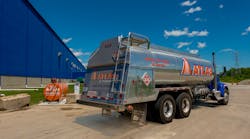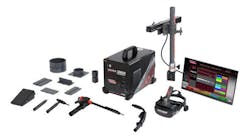On-site fueling can help a fleet gain control of its two biggest expenses: fuel and labor. Fleets just need to have a plan that facilitates proper implementation and ongoing management.
"Our research shows that fleets often sink 25 to 30 cents per gallon in lost wages when drivers fill up at gas stations," says Jeremy Whiddon, vice president of business development at Atlas Oil. "When filling up in their own yards, on the other hand, drivers have a tendency to waste a lot less time—especially if there are security cameras on the premises." Atlas Oil is a national fuel distributor based in Taylor, Michigan.
On-site fueling can also help fleets save money on fuel itself. First of all, fuel is bought on the open market from any number of suppliers.
"In the commodity world of fuel, pricing can get highly competitive," Whiddon says.
Secondly, a fleet can enter into a fixed forward contract where pricing is set for a certain amount of fuel over a specific period of time. This allows the fleet manager to better predict and manage costs.
Of course, a fixed forward contract could also backfire.
"Storing fuel with market volatility can be risky," says Gus Pesaturo, senior vice president at Diesel Direct. "Without hedging the product, you open yourself to gambling on market conditions." Diesel Direct is a nationwide fuel supplier based in Stoughton, Massachusetts.
Even if a fleet does end up locking in what proves to be a great price, there are other potential pitfalls when bringing fuel on site.
"You have the liability of having stored fuel," Pesaturo points out. "You still have drivers spending time fueling their trucks. If there's a lot of congestion in your yard, this lost driver time can add up."
This is why Pesaturo is a proponent of truck-to-truck fueling, a service offered by some companies such as Diesel Direct.
"You can have one of our fueling trucks come to your yard at night when your trucks are parked and your drivers have gone home," Pesaturo says. "You don't have to worry about your drivers' downtime or any of the liability associated with storing fuel."
There naturally is a cost to services like this. It's up to each fleet to evaluate what the expected ROI could be to determine the best option for an operation. The bottom line is that fueling a fleet on site makes a lot of sense. Making it work from both an efficiency and cost-savings standpoint requires a good plan and great execution.
Insights on above-ground storage
Above-ground fuel storage is much more common for fleets than in-ground storage systems. There are some drawbacks to the above-ground method, though. For instance, an above-ground storage tank (AST) is exposed to storm damage, vandals and moving vehicles. However, there are also many benefits.
Installation of an AST is easier than a below-ground system. ASTs are easier to access for inspections and cleaning. They're easier to relocate. It's also easier to clean up spills and contain leaks when fuel is stored above ground.
Permitting and other regulatory hurdles are more lenient when fuel is stored above ground. It's important to understand the local regulations fleets must comply with, because they can vary from state to state and even municipality to municipality.
Nearly all states require an SPCC (spill prevention control and countermeasure) plan when storing a significant amount of fuel, as would be the case with a fleet. Typically, the plan must be kept on site and also filed with the local municipality or regulatory agency. Part of the SPCC includes regular tank inspections and maintenance.
Choosing a reliable tank
There are a couple of construction standards to look for when choosing an AST. The UL 142 standard provides details for steel type, wall thickness, compartments, fittings and other specifications. UL 2085 standard is a standard for insulated above-ground tanks. Tank insulation helps to slow down the vaporization of the flammable liquid, which slows down the time in which the tank could become pressurized and explode. The Steel Tank Institute says both UL 142 and UL 2085 standards are adequate for fuel storage.
As user needs have evolved, UL 142 has evolved itself. Whiddon says it has become the gold standard for double-wall tanks, a product design that is trending in popularity.
"Some states require double-wall tanks, while other states strongly recommend them," Atlas Oil’s Whiddon says. "You have your fuel tank, but also a secondary tank around that. Should there be a leak or spill, that excess fuel will be contained."
UL 142 has also evolved to offer guidance on ASTs that are rectangular.
"Rectangular tanks are easier to move around," Whiddon explains. "They can also be stacked."
Pump technology has not changed a great deal over the years, Whiddon points out. One thing to consider, though, is safety.
"Diesel pumps and gas pumps could be used interchangeably," Whiddon says. “Since gas is more explosive due to its lower flash point, you may want to consider an explosion-proof electrical pump if storing gas."
Managing fuel consumption
Another important decision to consider is the capacity of the tank.
"We remind our customers that they will receive their biggest price break when they buy a truckload of fuel, which is roughly 7,500 to 8,000 gallons," says John Bolderson, sales manager for Envirosafe Fuel Systems. "That means a fleet would want an 8,000- to 10,000-gal tank. This will give them the most bang for their buck." Envirosafe is a Florida-based manufacturer of above-ground fuel storage tanks and turnkey fuel storage systems.
At the same time, fleet managers need to verify the fleet's rate of fuel consumption so they are not storing too much for too long.
"Today's fuels will last a while, though, and you can always look at additives," Bolderson points out.
In the event that a fleet burns through fuel quickly—more than 10,000 gallons a month—they should consider a larger tank.
"Then you might want to have a 12,000-gal tank so you can receive a full load and a half load every month," says Curtis Evans, Envirosafe general manager.
Technology has made managing fuel consumption much easier and more precise.
"There are several important functions to any good fuel-management system," Bolderson says. "You need a locking mechanism. You need an activation mechanism such as a card, pin or barcode. You want to be able to set parameters as to how much fuel a particular driver is authorized to have. Some systems will even help you track other essential vehicle maintenance needs like oil changes and tire rotations."
Companies like Envirosafe offer several types of fuel-management systems.
"There are entry-level systems starting with a single hose, and much more sophisticated systems with dozens of hoses," Bolderson points out. "A fleet manager needs to work with his supplier to identify which system makes the most sense."
Atlas Oil offers a cloud-based system called RIoS that can be directly mounted to a fuel tank. A driver can pull up to the tank, enter a pin to authorize fueling, scan a code using an app with his or her smartphone and begin fueling. All of the fueling data is captured by RIoS and fed into the cloud through either an internet or wireless connection.
Diesel Direct's Fuelloc is a cloud-based, barcode-driven system that works similarly. The driver scans the barcode on his truck using a scanning device that comes with the Fuelloc system. Once confirmed that the truck is authorized to be fueled with that type of fuel, the pumping begins—as does the data collection.
All of this fuel-consumption data, along with real-time inventory levels and other reports, can then be viewed via the system provider's cloud-based web portal or mobile app.
Technology is also helping to streamline deliveries.
"You can establish a very cost-effective fuel-monitoring system on any size tank," Atlas Oil’s Whiddon says. "It will take several tank readings a day. You can set up low-level alerts. Through cellular connectivity, text messages can be sent directly to your fuel supplier that you need a delivery."
Maintaining fuel quality
Once a facility begins storing fuel on site, the fleet assumes responsibility for preserving fuel quality. Unless it takes several months to burn through a tank, fleets shouldn't run into too many issues. Regardless, it's important to keep some things in mind.
"If your fuel tank filters are clogging up faster than normal, that's a pretty good indication that something is going on," Envirosafe’s Bolderson says.
"Fuel isn't going to go bad out of the blue," Envirosafe’s Evans adds. "But if it has been sitting around for a few months, especially during really hot and humid months, you definitely want to start looking at it more closely. You might even want to have it tested."
"Anyone storing fuel should be pulling fuel samples at least once per year," Atlas Oil’s Whiddon says. "We actually recommend doing it quarterly. This is a little more involved than just taking a squirt from the nozzle, although that can be helpful too. But the better method is to have a company come out and do the fuel sampling for you.
"We work with a company called Diesel Fuel Doctor," Whiddon continues. "They find a vent in the tank and drop in a device called a ‘bacon bomb.’ That sinks to the bottom and pulls a sample. The bottom of the tank is where a lot of the problems start. That's because water is heavier than both diesel and gasoline. And let's face it, water happens in fuel. Also, condensation builds up inside of a tank, especially when there are great fluctuations in temperature from night to day."
Too much water in a tank is very problematic. Obviously, fleets don't want too much water getting into the fuel. Furthermore, water facilitates microbial activity.
"You can get fungus, yeasts and molds growing inside of those tanks if the water isn't dealt with," Whiddon says. "Regular fuel samples will help identify these issues. You may need to have the fuel polished." Fuel polishing is the process of removing the fuel from the tank, running it through an advanced filtration process, and then returning the fuel.
Maintaining fuel equipment
The ongoing maintenance of fueling equipment is relatively straightforward, but very important nonetheless.
"A monthly walk-around visual inspection is a good practice," Envirosafe’s Evans says. "There are some items that are wear items: hoses, nozzles, breakaways and filters. They tend to wear out within a couple years of service, and likely much sooner than that. We advise fleets to keep these items on-hand in case something needs replacing."
Check nozzles and hoses for breakage and leakage points. Filters are also important to watch.
"Filters tell you when they need to be changed because the flow rate starts slowing down," Whiddon says. "Beyond an obvious warning sign like that, it's a good idea to change the filters at least once a year."
While UL-listed tanks are very durable, problems can still occur over time. Atlas Oil’s Whiddon says a tank will often reach the end of its life within 20 years. Even on a much newer tank, fleets should regularly inspect for signs of rust or corrosion. On that note, drivers should be trained on what to look for and how to report their findings.
"If you're in an environment where there's a lot of salt in the air or on the roads, your tank could wind up having some corrosion issues," Evans says. "When you start seeing signs of corrosion, you need to touch up the tank. That's why we recommend keeping some touch-up paint on hand in addition to those common wear items."
A local regulatory body (i.e. municipality or fire department) will dictate the inspection procedure. As pointed out earlier, regular inspections and maintenance are part of a fleet’s overall SPCC plan.
Whiddon recommends that a spill kit be kept on-hand that includes absorbent rags made for petroleum spills, along with containment booms to wrap around puddles.
"If your tank is near any drains, you also want to keep some drainage mats handy," Whiddon adds. "It's also important to align with a fuel supplier that has a contract with a hazmat company that can respond quickly should a more significant spill take place."
Conclusion
There are many benefits to bringing fuel on-site. Partnering with a reliable supplier that can streamline and simplify the installation and management of a fleet’s on-site fueling operation can help fleets take advantage of these benefits. There is also a lot that can go wrong. A good supplier will help to ensure that it all goes right.




